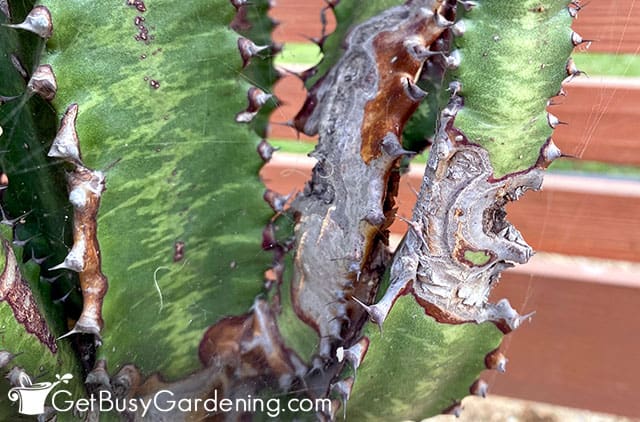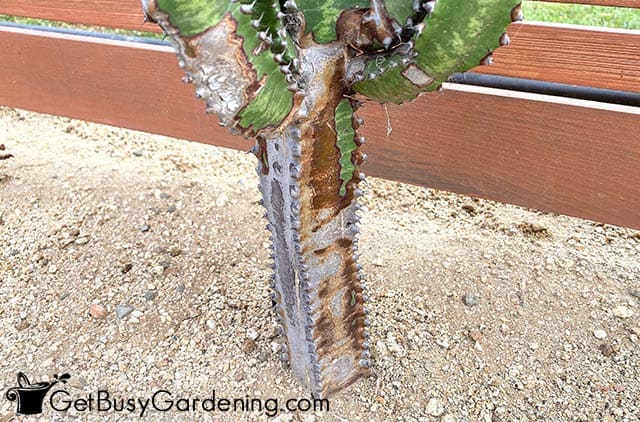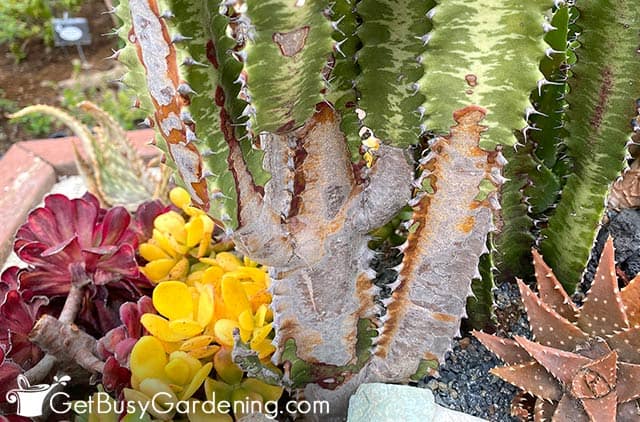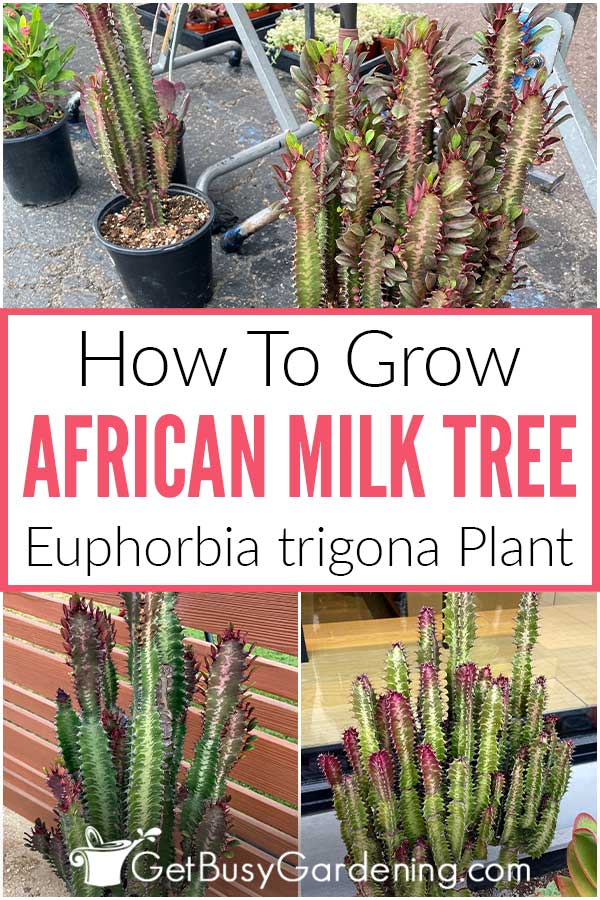African milk trees are beautiful and surprisingly easy to grow and care for. In this post, I’m going to tell you everything you need to know about Euphorbia trigona plant care, and give you tons of tips for keeping yours happy and healthy.

Whether you’re into indoor plants, or looking for a stellar addition to your landscaping in warmer climates, then African milk tree is an excellent choice.
With the proper care, your Euphorbia trigona can live for decades, and will grow into an impressive specimen.
Read on to learn all you need to know about how to grow African milk trees.
Including what kind of soil and sunlight they need, how to water and prune them, plus many other key tips for keeping yours thriving.
What Are African Milk Trees?
Many people wonder what an African milk tree is. Is it a tree, a cactus, or a bush? Euphorbia trigona are are actually succulents, and they originated in West Africa.
In their native habitat, these fast-growing plants form dense thickets. But here in the US, they’re more commonly kept indoors as houseplants.
Its common name comes from the milky white sap that is inside and bleeds out when it’s cut or damaged. But it also goes by the names candelabra cactus or cathedral cactus due to its unique shape.
Fully grown specimens can reach 8’ tall. They look tree-like, with ridged, rectangular branches reaching upward into a dense, candelabra shape atop a narrow, single bottom stem.
The stems have two sets of spikes all along the outer ridges, and the branches form small leaves between the spikes on the tips.
Different Types
There are a few different types of African milk trees you can grow. While most are green, you may also come across the Euphorbia trigona ‘Rubra’ or ‘Royal Red’.
It requires the same care. But, when exposed to bright sunlight, the tips will turn red along the stem ridging and leaves, creating a striking bi-colored appearance.
Toxicity
All parts of Euphorbia trigonas are poisonous if ingested, and the white sap can be a skin and eye irritant. So, if you’re worried about the toxicity, then make sure to take steps to protect yourself.
Using proper equipment, like gloves and protective glasses, is an easy way to handle them safely. In any case, it’s a good idea to keep it out of the reach of kids and pets.

How To Grow Euphorbia trigona
Before we chat about how to care for African milk trees, let’s go over a few key details about where to grow them so you know you’ll be setting yourself up for success.
Hardiness
Euphorbia trigonas are a perennial succulent that will live for many, many years given a dry, warm climate that doesn’t drop below freezing.
Here in the US, that most often means they’re indoor plants, at least for part of the year.
But they are hardy in zones 9-11. So if you live in a warm location, you can leave them outside in your garden year round.
Where To Grow African Milk Trees
If you live in a region that experiences below freezing temperatures, you’ll need to bring your African milk tree indoors during the winter.
For those living in warm enough climates, Euphorbia trigona will happily grow outdoors where it can get lots of direct sun. Make sure you give it plenty of room though, these babies can get huge.
I bring mine inside for the cold months, then move it back outside during the summer. If you do this, be sure to expose it to the direct sun gradually in the spring to prevent sunburn.

African Milk Tree Care Instructions
Now that you know where to grow your African milk tree, let’s learn the ins and outs of how to provide the best care.
Light
These succulents love light and will need a sunny location, such as a south facing window indoors.
If you begin to see leggy growth, it’s hunting for light. So move it to a brighter location, or add a grow light to help it along.
If you’re able to plant them outdoors in the garden, your candelabra cactus will do best in full sun. But they can tolerate partial or light shade.
Keep in mind that they are highly susceptible to sunburn. So, if yours is new or it’s used to indoor light, gradually introduce it to the full sun outside.

Water
Euphorbia trigona is drought tolerant and will thrive when allowed to dry out completely between waterings.
They don’t tolerate wet soil or soggy feet, and overwatering is the number one cause of issues for them. A little neglect is a good thing!
- How often should you water an African milk tree? – More important than any schedule is to always check the soil first. If it’s damp at all, wait for it to dry out before watering again.
- When should I water my African milk tree? – Water it when the soil is completely dry, give it a thorough drink, then drain off any excess from the tray. If it’s outside, do this in the early morning to allow it to dry before evening.
In the summer during their most active growth period, you may need to increase waterings. But you should still always check the soil first.
If you’re prone to overwatering, I recommend picking up an inexpensive soil moisture gauge to help you get it right.
Related Post: How To Water A Succulent Plant
Fertilizer
African milk trees don’t need any special type of fertilizer in order to thrive. But, just like all plants, they will benefit from being fed once in a while.
The best time to fertilize them is in the spring or summer during their most active growing period.
Choose general purpose and all-natural options, like organic succulent fertilizer, houseplant food, or compost tea to give it a healthy boost.
Avoid synthetic chemical fertilizers, as they do more harm than good, and don’t feed them at all in the fall or winter during their dormant period.
Soil
Just like all succulents, growing African milk trees is easiest in a sandy, fast draining soil. They aren’t particular about pH, so giving them a good home is pretty easy.
You can make your own DIY succulent soil, purchase a quality commercial potting soil, or use a gritty mix.
Outside, if your soil is too rich or dense, amend it with some perlite, coarse sand, or pumice to improve the drainage.

Transplanting & Repotting
Euphorbia trigona has shallow roots and will happily grow in the same pot for many years. But, as these towering specimens mature, they can become top heavy and fall over.
If you notice leaning or tipping, it’s time for a larger, heavier pot. The good news is they’re very easy to repot.
To avoid the risk of overwatering, only go up one pot size, and make sure it has plenty of drainage holes. Then simply position it at the same depth it was in the original container.
Give it a light watering in its new home, and let it settle for two weeks before resuming regular care.
If yours becomes very large outdoors, it can be pretty difficult to transplant or move. So in warm areas, make sure you find a good spot for it in your garden, where it can live for decades to come.
Pruning
As gorgeous as a full grown African milk tree is, they can get really big. So, if an 8 foot spiky plant is too much for you, learning how to prune it can be a great way to manage the size and maintain the shape.
They can handle a hard pruning, so you can’t really go wrong here. Just make sure to use a heavy-duty pair of pruners or a sharp knife so you don’t crush the stems. I also highly recommend wearing both gloves and eye protection.
You can cut them anywhere along the stems, or even remove entire branches if you want. The more you trim off, the bushier they will become.
Uneven pruning will make them more susceptible to tipping over. So make your cuts around the entire plant to keep the weight evenly distributed.
Common Pests
Outdoor African milk trees, and healthy indoor ones, don’t often have issues with pests. But, occasionally you might deal with spider mites, mealybugs, whiteflies, or scale.
Thankfully there are a few easy natural remedies and treatments that work to get rid of these pests.
Use organic insecticidal soap or a neem oil solution to spray on affected plants. Or, dip a cotton swab in rubbing alcohol and dab it on to kill and remove the bugs.
You’ll definitely need to apply these remedies more than once for serious infestations. In any case, the best way to avoid pests is to keep yours healthy following the instructions above.
How To Propagate Euphorbia Trigona
It’s easy to propagate African milk trees from stem cuttings of any size. For best results, take a 3-4” cutting (or save some while pruning) and rinse it under cool water until the sap stops flowing.
Then lay it in a dry spot for several days until the wound calluses over. Once calloused, dip the cut end into rooting hormone, and place it into a sandy soil mix.
Keep the rooting medium dry, but the air humid, and in about two months your cutting should take root. You’ll know it has roots when you see new growth on top.

Troubleshooting Common Problems
African milk trees are pretty low maintenance and easy to care for. But if you run into any of the issues below, here are my tips for how to get yours thriving again.
Euphorbia trigona Keeps Falling Over
Short roots and lots of top-heavy branches make tipping a common issue for Euphorbia trigona. To keep it from falling over, there are a few things you can do.
If possible, repot it into a larger, heavier container. You could also trim it down to a more manageable size, or use a heavy-duty stake to secure it and keep it upright.
Yellowing Leaves
It’s very common for African milk trees to lose leaves as they mature. But if the leaves are yellowing, it’s a sign of over or underwatering.
To fix this issue, make sure you are giving it the correct amount of moisture. Let the soil dry out between waterings, and always drain off any excess afterward.
Brown Spots
Brown spots on your African milk tree can be caused by a number of issues. The most common one is called corking.
Corking is a natural process that forms thick, firm brown patches on base of the stem as it ages. It is totally normal and nothing to be concerned about.
However, brown spots can also be caused by sunburn, bugs, or rot due to overwatering.

Sunburn
Like I’ve mentioned a few time, sunburn is a really common issue for African milk trees. It usually happens when they’re used to being inside, and then they’re suddenly exposed to direct sun outside.
To prevent this, slowly introduce it to the sun when moving it outside. If yours is experiencing sunburn indoors, move it to a different location that gets bright light, but is protected from the hot afternoon rays.
Root Rot
If the spots near the base of your plant are soft and spongy, you’re dealing with root rot, which was likely caused by overwatering.
Sadly, there is no cure. Once it starts to rot, it will continue to move up the stem, and eventually kill the whole plant. If this is happening to yours, it’s best to take healthy cuttings and begin again.
FAQs
Now that I’ve discussed exactly how to grow and care for an African milk tree, I’ll answer the most common lingering questions. Read on to see if I’ve already answered yours.
Is the African milk tree really a tree?
No, the African milk tree is not really a tree, but a succulent that grows very tall and bushy, giving it the appearance of a young sapling.
Why is the trigona called a “milk tree”?
The Euphorbia trigona is called a ‘milk tree’ because it oozes a milky, white sap when it’s cut or damaged.
Is African milk tree poisonous?
Yes, all parts of the African milk tree are poisonous if ingested. The white sap can also be a skin and eye irritant. So it’s best to always wear safety glasses and gloves when handling the plant.
Why is my African milk tree dying?
The number one reason why African milk trees start dying is due to overwatering, which will cause it to rot from the bottom up.
Other possible causes are an exposure to freezing temperatures, severe sunburn, or a large pest infestation.
Why is my African milk tree turning red?
If your African milk tree is turning red then you probably have the Royal Red variety. They will turn red when exposed to intense, direct light.
This is completely normal and nothing to worry about, just sit back and enjoy their beautiful red tips.

How tall do African milk trees get?
African milk trees get very tall in their native habitat. They can grow to be as tall as 8 feet in height, but can be kept smaller through pruning, if desired.
Does the African milk tree flower?
It’s very uncommon for African milk trees to flower, especially when grown indoors. However, mature and tall bushes that are outdoors may produce small, insignificant white flowers in the summer.
How fast does African milk tree grow?
African milk trees grow fast, and can get several feet taller every year.
Now that you know how to grow African milk trees, you’re ready to add one to your plant collection. With a baby from the nursery, or a cutting from a friend, you’ll be able to grow a towering, full Euphorbia trigona easily with these care tips and tricks.
If you want to learn all there is to know about maintaining healthy indoor plants, then you need my Houseplant Care eBook. It will show you everything you need to know about how to keep every plant in your home thriving. Download your copy now!
More About Houseplant Types
- How To Grow & Care For Plumeria Plants
- How To Care For Mother Of Millions Plant (Kalanchoe delagoensis)
- How To Care For Pencil Cactus (Euphorbia tirucalli)
- How To Care For A Jade Plant
- How To Care For String Of Hearts (Ceropegia woodii)
- How To Grow & Care For Echeveria Plants
Share your African milk tree care tips or questions in the comments section below.






Sharon says
I just purchased a an African Milk Tree that is is brown near the bottom, how do I tell if it’s corking. I got it from someone that’s had it since 2016 and about 3 ft tall.
Amy Andrychowicz says
As long as the brown part of your African Milk Tree’s stem is firm, and not soft or rotting, and the plant looks healthy, then it’s most likely turning brown because of corking.
shirley stengrim says
I live in Mesa AZ. I have a 7ft potted African Milk Tree out side in a large pot. Can I plant it in the ground in my yard?
Amy Andrychowicz says
Yes, I believe African Milk Trees are hardy where you live, they can survive down to zone 9b.
Zac Statts says
I have had a milk tree now for 16 years he is very tall this year I’d put him outside a little bit and I’m curious he is turning colors and it seems to be purple don’t know what I can do or should do to help my plant
Amy Andrychowicz says
If you put your African milk tree directly into the sun after it’s been indoors, then the color change could be caused by sunburn. When you move them outside, it’s best to slowly acclimate them to the full sun over a period of a 4-6 weeks.